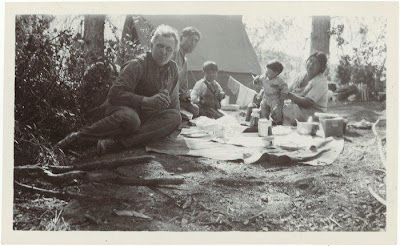 |
| Ethnologist Mark R. Harrington in Mill Creek Canyon. California, 1927. |
Recently, we had visitors that were participating in the Breath of Life Archival Institute for Indigenous Languages. The native participants spent two weeks conducting archival research at the Library of Congress, the National Anthropological Archives, and the National Museum of the American Indian. The research was centered on discovering language resources in order to help revitalize endangered or lost native languages. We were able to provide some relevant linguistic material for our visitors from the Museum of the America Indian, Heye Foundation records.
Since it is the beginning of summer, and all I can think
about is going swimming, I thought it would be interesting to compare linguistic
material relating to water from several North American tribes: Haudenosaunee (Iroquois), Panawahpskek (Penobscot), and Peskotomuhkati
(Passamaquoddy).
Haudenosaunee (Iroquois):
 |
| The notecards pictured above were recorded by Mark Raymond Harrington (pictured above) c. 1929. The MAI Foundation records holds 244 of the above linguistic notecards. |
Peskotomuhkati (Passamaquoddy):
 |
| These notes were taken by William B. Cabot during the year 1934. |
Panawahpskek (Penobscot):
 |
| The notes taken above were recorded by William B. Cabot during a stay with Chief Neptune during the year 1933. |
It will be great to see how the visitors from the Breath of Life Archival Institute use the materials they looked at during their visit to the NMAI Archive Center.
If the topic of endangered languages interests you I suggest visiting the 2013 Smithsonian Folklife Festival! The festival runs from June 26th – July 3rd and takes place on the National Mall. It will feature a program titled "One World, Many Voices: Endangered Languages and Cultural Heritage."
Happy
Summer!
National Museum of the American Indian Archive Center







No comments:
Post a Comment